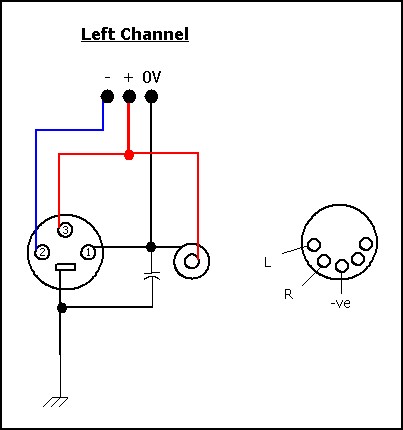I've got a Cambridge CD6 at work, and it's currently connect to my 32.5 using a Chord Cobra 2 interconnect. However, I would like to convert a spare Naim interconnect to use the CD6's balanced outputs.
The CD6 actually has two XLR output jacks, one each for the left and right channels. I know that I'll have to rewire one to carry both signals, and I'm confused as to which "ground" I should use. Here's a circuit diagram of one output channel of the CD6, along with the input pin-out for the 32-5.

Note that there is the black "0V" connection that is used for the jacket connector on the RCA plug, so this is probably audio ground. However, there's also chassis ground (connected to "0V" via a small capacitor). Finally, there's a blue "-" connection.
Although I'm pretty sure that I should be using the "0V" connection for common ground going to "-ve" on the Naim input, I'm curious as to what the other two "grounds" represent.
Are there any brave souls out there who would care to explain this to me? I would also appreciate some assurance that I'm going the right direction with this. Is this worth the trouble, or should I just stick with the Chord interconnect? Thanks for the help. Catch you later!
-=> Mike Hanson <=-
Smilies do not a forum make.
Posted on: 12 September 2000 by Mike Hanson
I should mention that the double circle in the middle of my diagram is a poor representation of a female RCA socket. Also, this diagram is drawn looking at the back of the player.
Another question: I understood Naim CD players are to provide the only ground reference in the entire electronics chain. Is this ground at the CD supposed to be the the audio ground, the chassis ground, or are they one in the same? As you can see from my diagram, the CD6 has the audio output ground buffered from the chassis ground.
Catch you later!
-=> Mike Hanson <=-
Smilies do not a forum make.
Posted on: 12 September 2000 by David Dever
Mike-
Unless the outputs are transformer-balanced (not likely on an inexpensive CD player), use the + ("hot") output from each channel for the signal. Depending on circuit board layout, you may be able to use the 0V from one side as the common audio ground.
The cold (-) output serves no purpose here, nor does the capacitively-coupled (for EMC regulations) chassis ground.
Dave Dever, NANA
Posted on: 12 September 2000 by Mike Hanson
Yes, I suspected that I could use the "0V" line for my common ground. Each channel's "0V" comes from a different spot on the board, but I've stuck my DMM on them and they seem to be connected. I've not tried removing the circuit board to see if the traces are connected, though. Regardless, my Chord Cobra 2 connects them at the 32.5, so quells my fears.
I'm going to remove the blue "-" wire from one XLR socket, and replace it with the red "+" from the other socket. Then a single XLR jack will provide Ch. 1+, Ch. 2+, and -ve. I'll chop the Naim plug off an old interconnect (I upgraded to a lavender one at home), and I'll replace it with a female XLR. I think this will be easier than trying to fit a Naim-style DIN socket to the player. Catch you later!
-=> Mike Hanson <=-
Smilies do not a forum make.
Posted on: 13 September 2000 by Phil Sparks
For balanced operation the blue '-' on the xlr is exactly the opposite of what appears on the red wire. So if you've got zero on the 0v pin (unsuprisingly!) and a music signal of say +0.2v on the red wire then you should have -0.2v on the blue wire. The idea being that at the far end of the connection you take the difference between the + and - wires, any interference that has been picked up on the journey from CD to amp will affect the + and - equally and by taking the difference it cancels out. Balanced operation originated at gigs, e.g for microphones where the signals are small and could be travelling 10s of yards before getting to the mixing desk - in this circumstance imunity to interference is obviously a big benefit.
If I recall there was a naim view on balanced operation on the old forum saying that the complexity of adding balanced operation buggered up the sound much more than any interference benefits.
Phil

